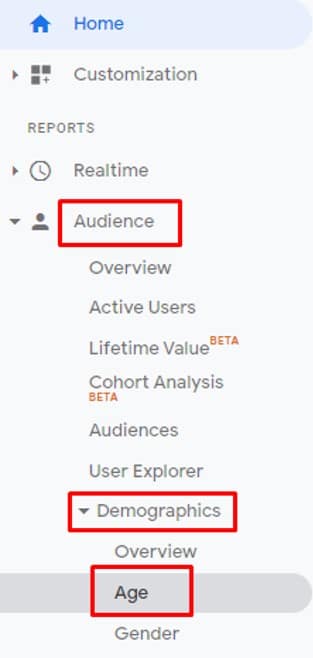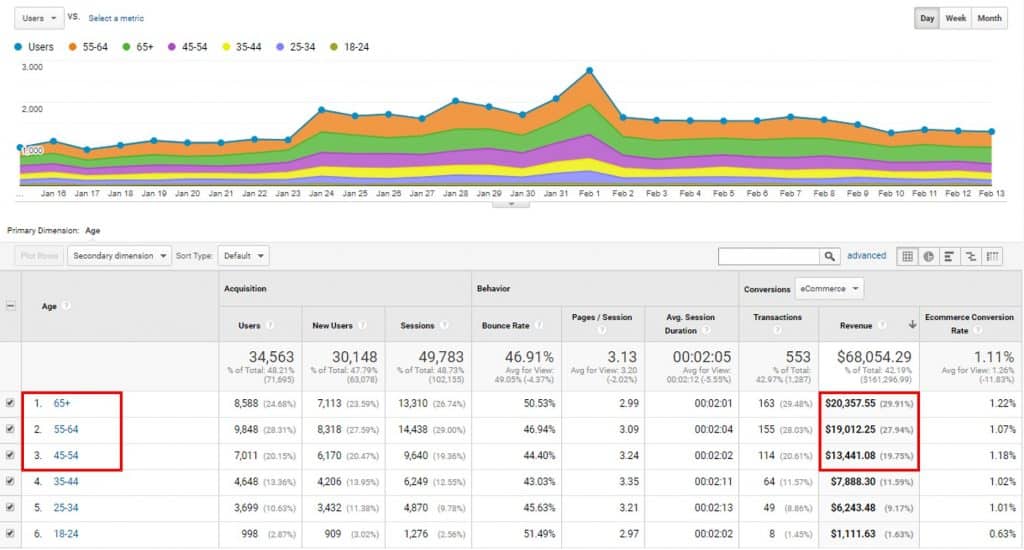Age is one of the most overlooked metrics in a paid search marketer’s toolbox. Knowing the age of your users and how (and where) they respond best is key to managing a healthy search marketing strategy.
Where to Find Age Demographics
Google Analytics is a great source of demographic information — including age data — about your site’s visitors. To view it, select “Audience,” “Demographics,” then “Age,” as shown below.

The resulting graph, shown below, shows data for age groups from 18 to 24 at the low end to the oldest group of 65 and over. Google doesn’t share the data for visitors 18 and younger, but you’re not allowed to target those age groups anyway in Google, Microsoft, or Verizon.

How to Use Age Demographics
In the example above, 78% of revenue is coming from ages 45 and older. Why is this information important?
1. Messaging: The ad messages, regardless of whether you’re advertising with text, display, or video, should be drastically different for a 24-year-old versus a 65-year-old. Younger people may be looking for a completely different set of features and benefits than more mature searchers. They may also respond better to different styles of communication.
2. Ad Channels: If your age data skews older, it’s likely you won’t find them on Instagram, but you very well might find them in the Google Display Network. If your data skews younger, Google Video campaigns targeting your demographic on YouTube or the new Discovery Channel beta might be the way to go. This insight can help you decide what ad channel to use to reach your audience. You should test other channels, but the data gives you a place to start.
3. Bid Optimizations: You can bid differently or even exclude age groups entirely based on age data.
An Age Demographics Use Case
Our example data above showed that 78% of revenue comes from visitors aged 45 and up. Here’s how I would use that information.
1. Search Ad Bid Modification: Google Ads and Microsoft Advertising both allow you to make bid adjustments based on age. Use age to control budget and messaging by doing one of the following:
- Bid down on the age groups in a single campaign or ad group that drive less revenue, or exclude them entirely.
- Create duplicate ad groups — one for 45 and older, and one for 44 and younger — and set up different bids and messaging.
- Create duplicate campaigns — one for 45 and older, and one for 44 and younger — and set up different bids and messaging.
2. Non-search Networks: Knowing your age demographic and where they tend to spend their time outside of search can help you determine which channels and ad types to test. Here’s some of the places and ways to use your age data.
- Google Display Ads: Google’s Display Network relies on audiences and if you know what audience you are targeting and what messaging will resonate with them, the network can be a valuable branding tool, and even drive conversions to your site. Targeting options are the same as detailed above for Search ad bid modification based on age:
- Bid up or down on specific age groups.
- Create duplicate ad groups.
- Create duplicate campaigns.
- Google Discovery Ads: Google’s equivalent to social advertising, this beta program shows ads in a story format on the Google app. Because it’s an app, it’s entirely mobile-dependent. If your demographics are older and skew heavily to desktop, Discovery may not be the right place to invest your money. Conversely, if your audience skews young, it could be an excellent place to test.
- Microsoft’s Audience Network (MSAN): Similar to Google’s Display network, MSAN has an impressive list of targeting audiences, as well as age demographics and LinkedIn data like job function and company type.
- Verizon Media Ads: While Yahoo’s search results are powered by Microsoft, Verizon Media runs its own native advertising platform. Formerly known as Oath, and Yahoo Gemini before that, Verizon Media’s ads display on Yahoo.com’s curated content portal.
The adage that “knowledge is power” is absolutely true. Knowing which age groups drive the most revenue or leads for your company can help you tailor your advertising campaigns with the right message and the right spend to achieve maximum performance.




